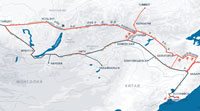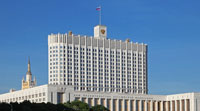
Annual report 2014

High-speed
transportation in Russia
The Development Programme envisages an increase in the length of rapid-transit and high-speed railway lines by 2030 to
11.7 thousand km
The development of rapid-transit and high-speed transportation is targeted in the Programme for the Development of Rapid-Transit and High-Speed Traffic on the Russian Railways Network until 2020 and the Railway Transportation Development Strategy in the Russian Federation until 2030.
The implementation of projects to develop rapid-transit and high-speed transportation makes it possible to satisfy growing public demand for passenger transportation, significantly reduce travel time and provide high-quality service.
Map of rapid-transit
and high-speed passenger
transportation until 2030

Map of rapid-transit and high-speed passenger transportation according
to the Russian Railway Transportation Development Strategy until 2030.
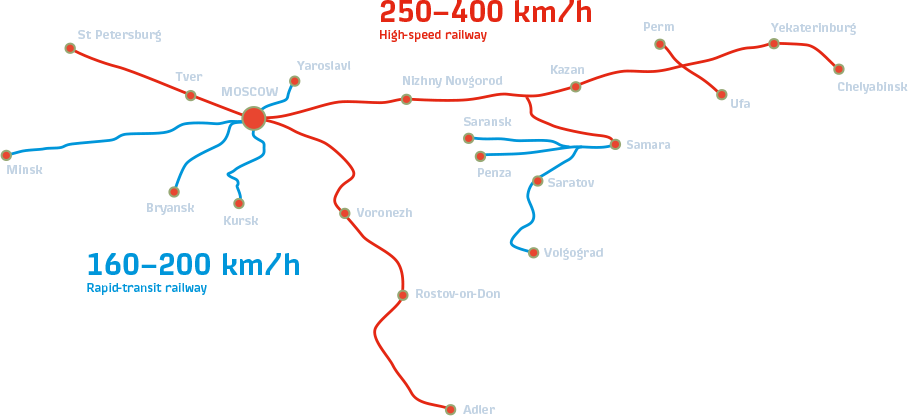

Operation of Russian-manufactured innovative passenger railcars
Capacity of double-decker sleeping compartment railcars expanded by
78 % | up to 64 passengers
Capacity of double-decker first-class sleeping railcars increased by
40 % | up to 30 passengers
In 2013-2014, innovative double-decker train traffic began on the highly congested Moscow-Adler and Moscow-St Petersburg routes.

In 2013-2014, innovative double-decker train traffic began on the highly
congested Moscow-Adler and Moscow-St Petersburg routes.

Operating costs
per passenger seat reduced by
38 %
on the Moscow-Adler route when operating double-decker trains
Life cycle unit cost
per passenger seat reduced by
40 %
on the Moscow-Adler route when
operating double-decker trains
Service life increased by
43 %
from 28 to 40 years
Payback period slashed by
41 %
on the Moscow-Adler route when
operating double-decker trains
In order to meet the increased demand for the Moscow- Adler and Moscow-St Petersburg routes, double-decker trains began running in
Introducing the new railcars makes it possible to provide high-quality passenger transportation services while reducing unit costs.
The new railcars are equipped with special lifts for people with limited mobility and a special two-person sleeping compartment.

Moscow-Kazan High-Speed Railway
In 2015–2016, the Government has decided
to allocate funds amounting to:
RUB 20,9 bln
The construction of the high-speed railway along the Moscow-Kazan route with an extension to Yekaterinburg is a pilot project for high-speed railways in Russia.
This project will meet the growing demand among Russian cities for passenger transportation, reduce passenger travel time and provide a qualitatively new level of service.

A number of measures were implemented in 2014 to prepare for the construction of the Moscow-Kazan High Speed Railway. In particular, an investment feasibility study of the project was prepared and approved by the Russian State Expert Evaluation Department. A technology and price audit of the project was conducted with leading international partners.
Special technical conditions were prepared and approved for the design, construction and operation of the high- speed railway. The Russian Government has decided to start developing design documentation and conducting engineering surveys and has allocated funds of RUB 20.9 bln in

Travel time from Moscow
to Kazan
3 hrs 30 min
Length of Moscow-Kazan
HSR track
770 km
Operational speed
350 km/h
Construction period
4 years
Living within
the railway’s zone are
30 mln people
Overall effect from the gross
output of the Russian economy
RUB 28.0 th
Overall budget effect prior
to 2013
3.4 th
Number of new jobs
370 thousand km
In 20 sectors of the economy

New Mansky Tunnel
On 26 August 2014, the grand opening of the new Mansky Tunnel took place on Krasnoyarsk Railways, one of the main facilities being built by Russian Railways to increase carrying capacity along the Mezhdurechensk-Tayshet route.
The opening of the tunnel along with the subsequent construction of a second track on the

The opening of the tunnel along with the subsequent construction of a second track on the
Total length of tunnel
2,465 m
The new Mansky Tunnel became the longest in the Krasnoyarsk Region and on Krasnoyarsk Railways (length of 2,465 m). It is located in the Partizansky District of the Krasnoyarsk Region on the 729 th km of the Mezhdurechensk-Tayshet mainline between the stations Lukashevich and Kravchenko. The tunnel runs under Argazinsky Pass in the Sayan Mountains on a route parallel to the old tunnel (59 m between them). It is impossible to organise train traffic on this section in any other manner without building a tunnel.
The new Mansky Tunnel makes it possible to eliminate infrastructural restrictions on one of the most challenging sections of the Mezhdurechensk-Tayshet mainline of the Southern part of Krasnoyarsk Railways.

Planned expenses on the modernisation programme for the Mezhdurechensk-Tay- shet mainline of the Southern section of Krasnoyarsk Railways prior to 2018

Project of the century

The Baikal-Amur Mainline was designed as a key component of an integrated project to develop the significant natural resources of the regions through which the railway runs. The transportation position of the Far East Region, with its direct railway access to major ice-free ports on the Pacific Coast such as Vanino, Nakhodka, Nakhodka-Vostochny, Vladivostok and Posyet as well as land border crossings such as Grodekovo-Suifenhe and Hasan-Tumangan, combined with growth in Russia’s economy and foreign trade with Asia-Pacific Region countries, creates favourable conditions to support domestic and international transportation.
Total length
4300 km
Each year the Baikal-Amur Mainline will transport approximately
12 mln passengers


Railway construction
and modernisation
Main projects involving the elimination of infrastructural constraints in 2014
Secondary tracks
63.3 km
Electrification
2.5 km
Stationary
tracks
98.3 km
In 2014, the Company rebuilt:
Contact network
249.5 km
Railway tracks
3,950 km
Traction substations
31
Long-haul cable communications lines
562.9 km
Main projects involving the elimination of infrastructural constraints in 2014:
- Reconstruction of the Mga-Gatchina-Veymarn-Ivangorod section and railway approaches to ports on the south coast of the Gulf of Finland;
- Construction of secondary railway tracks and electrification of the Vyborg-Primorsk-Yermilovo section;
- Organisation of rapid-transit passenger traffic on the St Petersburg- Buslovskaya section (2nd stage);
- Comprehensive reconstruction of the Trubnaya-V. Baskunchak-Aksarayskaya section;
- Development of the Tobolsk-Surgut-Korotchayevo section.
Investment in projects to eliminate infrastructural constraints in 2014 totalled
RUB 31.3 bln

Development of the railway
infrastructure of the Moscow
Transport Hub
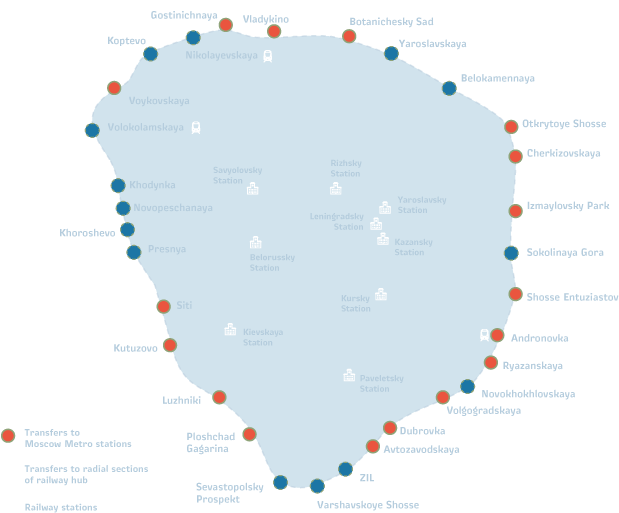
Total planned funding and expenditures on the Moscow Transport Hub development project in 2012–2025
RUB 524.9 bln

Russian Railways launched extensive work in 2012 to modernise and develop the railway infrastructure of the Moscow Transport Hub. Reinforcing the railway infrastructure of the Moscow Region was planned as part of the Railway Transportation Development Strategy in the Russian Federation until 2030. Preparations are currently under way to implement three projects:
- the reconstruction of the Moscow Little Ring Railway;
- the reconstruction of the Moscow-Kryukovo section with the construction of a fourth mainline;
- the reconstruction of the Domodedovo (Aviation)-Domodedovo Airport section with the installation of additional mainlines.
The project ‘Reconstruction and development of the Moscow Little Ring Railway’ is being implemented as part of the development of railway infrastructure in the Moscow Transport Hub. Railway passenger transportation will be organised to ensure 100 electric trains run per day with intervals of less than 5 minutes during rush hour, which will enable more than 250 mln passengers to utilise the additional transportation interchange circuit per year.
 Interactive
Interactiveanalysis
 Development of the eastern
Development of the easternoperating domain
 Statement
Statementfrom President
 Statement
Statementfrom Chairman





